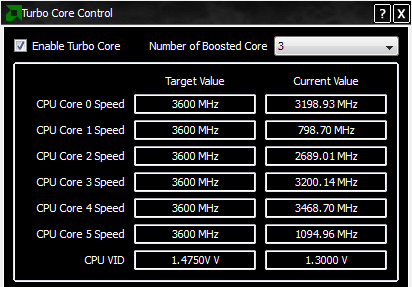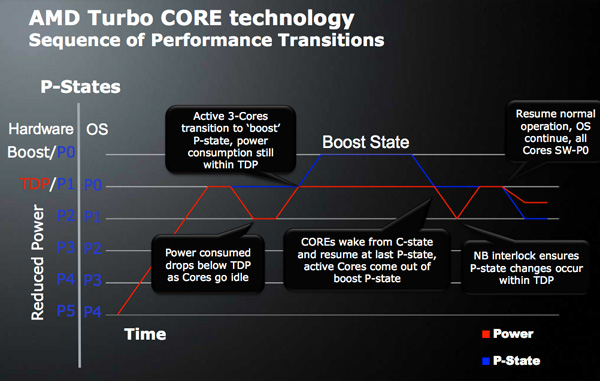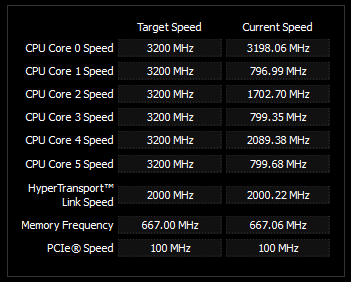AMD's Six-Core Phenom II X6 1090T & 1055T Reviewed
by Anand Lal Shimpi on April 27, 2010 12:26 AM EST- Posted in
- CPUs
- AMD
- Phenom II X6
AMD’s Turbo: It Works
In the Pentium 4 days Intel quickly discovered that there was a ceiling in terms of how much heat you could realistically dissipate in a standard desktop PC without resorting to more exotic cooling methods. Prior to the Pentium 4, desktop PCs saw generally rising TDPs for both CPUs and GPUs with little regard to maximum power consumption. It wasn’t until we started hitting physical limits of power consumption and heat dissipation that Intel (and AMD) imposed some limits.
High end desktop CPUs now spend their days bumping up against 125 - 140W limits. While mainstream CPUs are down at 65W. Mobile CPUs are generally below 35W. These TDP limits become a problem as you scale up clock speed or core count.
In homogenous multicore CPUs you’ve got a number of identical processor cores that together have to share the maximum TDP of the processor. If a single hypothetical 4GHz processor core hits 125W, then fitting two of them into the same TDP you have to run the cores at a lower clock speed. Say 3.6GHz. Want a quad-core version? Drop the clock speed again. Six cores? Now you’re probably down to 3.2GHz.
| Single Core | Dual Core | Quad Core | Hex Core |
 |
 |
 |
 |
 |
 |
 |
 |
This is fine if all of your applications are multithreaded and can use all available cores, but life is rarely so perfect. Instead you’ve got a mix of applications and workloads that’ll use anywhere from one to six cores. Browsing the web may only task one or two cores, gaming might use two or four and encoding a video can use all six. If you opt for a six core processor you get great encoding performance, but worse gaming and web browsing performance. Go for a dual core chip and you’ll run the simple things quickly, but suffer in encoding and gaming performance. There’s no winning.
With Nehalem, Intel introduced power gate transistors. Stick one of these in front of a supply voltage line to a core, turn it off and the entire core shuts off. In the past AMD and Intel only put gates in front of the clock signal going to a core (or blocks of a core), this would make sure the core remained inactive but it could still leak power - a problem that got worse with smaller transistor geometries. These power gate transistors however addressed both active and leakage power, an idle core could be almost completely shut off.
If you can take a single core out of the TDP equation, then with some extra logic (around 1M transistors on Nehalem) you can increase the frequency of the remaining cores until you run into TDP or other physical limitations. This is how Intel’s Turbo Boost technology works. Depending on how many cores are active and the amount of power they’re consuming a CPU with Intel’s Turbo Boost can run at up to some predefined frequency above its stock speed.

With Thuban, AMD introduces its own alternative called Turbo Core. The original Phenom processor had the ability to adjust the clock speed of each individual core. AMD disabled this functionality with the Phenom II to avoid some performance problems we ran into, but it’s back with Thuban.
If half (or more) of the CPU cores on a Thuban die are idle, Turbo Core does the following:
1) Decreases the clock speed of the idle cores down to as low as 800MHz.
2) Increases the voltage of all of the cores.
3) Increases the clock speed of the active cores up to 500MHz above their default clock speed.

The end result is the same as Intel’s Turbo Boost from a performance standpoint. Lightly threaded apps see a performance increase. Even heavily threaded workloads might have periods of time that are bound by the performance of a single thread - they benefit from AMD’s Turbo Core as well. In practice, Turbo Core appears to work. While I rarely saw the Phenom II X6 1090T hit 3.6GHz, I would see the occasional jump to 3.4GHz. As you can tell from the screenshot above, there's very little consistency between the cores and their operating frequencies - they all run as fast or as slow as they possibly can it seems.
| AMD's Turbo Core Benefit | |||||
| AMD Phenom II X6 1090T | Turbo Core Disabled | Turbo Core Enabled | Performance Increase | ||
| x264-HD 3.03 1st Pass | 71.4 fps | 74.5 fps | 4.3% | ||
| x264-HD 3.03 2nd Pass | 29.4 fps | 30.3 fps | 3.1% | ||
| Left 4 Dead | 117.3 fps | 127.2 fps | 8.4% | ||
| 7-zip Compression Test | 3069 KB/s | 3197 KB/s | 4.2% | ||
Turbo Core generally increased performance between 2 and 10% in our standard suite of tests. Given that the max clock speed increase on a Phenom II X6 1090T is 12.5%, that’s not a bad range of performance improvement. Intel’s CPUs stand to gain a bit more (and use less power) from turbo thanks to the fact that Lynnfield, Clarkdale, et al. will physically shut off idle cores rather than just underclock them.

I have noticed a few situations where performance in a benchmark was unexpectedly low with Turbo Core enabled. This could be an artifact of independent core clocking similar to what we saw in the Phenom days, however I saw no consistent issues in my time with the chip thus far.










168 Comments
View All Comments
Boogaloo - Tuesday, April 27, 2010 - link
That's pretty disappointing scaling from the 965 to the 1055T.. I'd be willing to bet the lack of added cache (not to mention the memory controller issues the article raises) are really holding back the performance. Unfortunately, 6 cores at 45nm hasn't left them with much of a choice as far as that goes.SonicIce - Tuesday, April 27, 2010 - link
looks like the 7z compression rate went down with turbo core enabled? an error?Ryan Smith - Tuesday, April 27, 2010 - link
Yeah, we accidentally flipped the chart. It has been fixed.FragKrag - Tuesday, April 27, 2010 - link
A bit underwhelming since before I read this bench, I saw overclock3d benches (they had 1090T at stock absolutely thrashing an i7 at 4GHz). Seems like the ideas that most of the people had with threading were true though. Overall I think they should be decently competitive because they do hold the advantage in cores.It's nice to see AMD pushing Intel a bit, though this does not make me regret my earlier purchase of the i7 860 as much as I would have liked it to.
Is there some kind of error with TurboCore? It doesn't look like it's working because those Dragon Age (optimized for quads?) and Dawn of War FPSs were a bit disappointing! :(
beginner99 - Tuesday, April 27, 2010 - link
Well as always for the last couple of years. This can't go on forever. Just if you think about the margins that intel has and the one that AMD has (if any...).The Problem I see is that in the cheaper price regions (=mainstream) users do not need a ton of cores. In the end most could easly live with 1 core even though 2 would probably lead to a "feelable" difference.
So I'm not sure if it's very intelligent to invest money in these designs. Just look at the die shot. I'm not an expert but you don't need to be to see that the just attached 2 more cores to an existing design probably having to make a ton of trade-off's (like the l3 cache).
I mean it is theoretically great. The easy upgrade path but again, how many users actually ever upgrade? IMHO a tiny fraction.
Of course thise i3/i5 dual cores from intel are overpriced. But that's what most company PC's will use. Huge profits for intel.
I hope at least AMD's answer to atom will be very good (=alot faster, same power consumption). But I doubt it...
ET - Tuesday, April 27, 2010 - link
The entry level crowd isn't the problem. Someone who only requires basic performance should buy the cheapest CPU, and AMD has that slot. For the performance crowd, Intel is the clear winner, but it's not the majority of the market. The real issue here is the price performance crowd, the people who want good performance for a good price. This is a pretty large market and AMD is trying to win here by reducing the price, but it's not doing great by this review.I think AMD still makes money on all CPU's, just not nearly as much as Intel.
Scali - Tuesday, April 27, 2010 - link
"Someone who only requires basic performance should buy the cheapest CPU, and AMD has that slot."I think that's his point though?
This CPU is not the 'cheapest'. Why invest in a design like this?
As Anand says in the conclusion, for 'mixed' usage, the i860 is a better choice. Only people who need heavily threaded performance may want this CPU. Especially at the pice at which AMD is selling these six-cores, can they really get a good return-on-investment on the development of this CPU?
Seems like dualcores and quadcores is where the bulk of the sales will be.
jamyryals - Tuesday, April 27, 2010 - link
Your argument is short-sighted. You can't stay with 4 core models indefinitely and expect to remain competitive in the future. R&D money has to be spent on the new technology even if your niche is the Price/performance budget sector.Scali - Tuesday, April 27, 2010 - link
I think it's short-sighted to just look at the number of cores.What AMD REALLY needs is a core architecture with a good IPC and relatively cheap to produce. That is what made the K7 and K8 so successful.
Currently AMD is just throwing more transistors at the problem, which is not a good thing, given their position (45 nm process vs Intel's 32 nm).
If anything Intel proves that it's not the number of cores, since Intel's quadcores generally outperform AMD's six-core. So as it stands today, Intel can stay with quadcores just fine.
beginner99 - Tuesday, April 27, 2010 - link
exactly my thought.But I must admit I did not think about servers at all. If it was easy to adopt a server cpu which had to be made anyway then it's a different story. (is it a half-magny-cours?)
But generally i would say a complete new architecture is needed soon to stay competitive.
Phenom architecture is quite old now and never was that good anyway especially compared to core architecture...